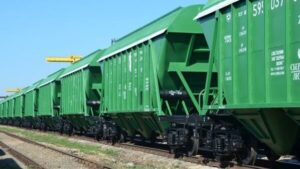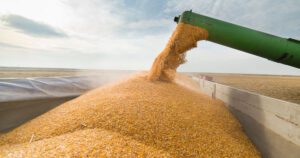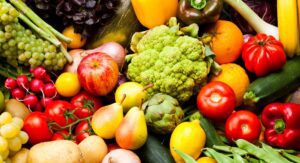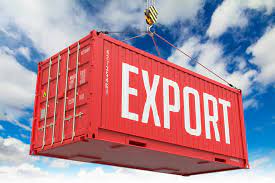
JSC Ukrzaliznytsia exported 804,900 tonnes of grain cargo in June 2022, which is approximately the same as last month (807,000 tonnes), Deputy Director of the Department of Commercial Work at Ukrzaliznytsia Valeriy Tkachev said on Facebook during online meetings with industry representatives on Thursday.
In particular, 639,900 tonnes of grain were transported through land border crossings on the western border, and 165,000 tonnes were delivered to ports.
Tkachev specified that in June 2022, Ukrzaliznytsia loaded 1.23 million tonnes of grain into wagons, which is 14% of the total loaded volume of 8.57 million tonnes.
At the same time, the volume of transportation of grain cargo amounted to 1.36 million tonnes in June, which is 10.5% more than the volume of loading for this period.
According to Tkachev, the volume of average daily loading into wagons in June amounted to 38,000 tonnes. This figure tends to decrease on weekends: if on weekdays 50,000-70,000 tonnes are loaded into Ukrzaliznytsia wagons, then on weekends – an average of 26,000 tonnes.

The port of Constanta (Romania) has begun using a floating crane to reload crops arriving along the Danube River on barges from Ukraine onto commercial ships for further shipment to third countries.
This will eliminate the need to reload grain to port granaries from the logistics chain and will increase the cargo flow processed by the port, according to the website of the Bulgarian publication Maritime.bg.
“Transport Trade Services (TTS) has launched a new comprehensive logistics project that provides a significant increase in cargo traffic from Ukraine, transported from the river ports of Reni and Izmail, and their subsequent loading onto commercial sea vessels in the port of Constanta,” the publication’s website states.
According to him, Ukrainian grain cargoes will be reloaded by a floating crane in the deep-water part of the port of Constanta directly from barges arriving by river transport to commercial vessels.
According to the publication, the first ship loaded according to the new logistics model was the Lausanne motor ship (the flag of Sierra Leone), which received 31,000 tons of grain from Ukraine.
As reported, due to the congestion of logistics routes in the Sulina Canal (Romania), Ukrainian exporters of agricultural products are forced to wait in line for loading grain carriers for 10 days or more, which in total causes them $500,000 in losses per day.
Ukrainian Minister of Agropolitics Mykola Solsky said that the logistics of Ukrainian agricultural products through Romania could become more complicated and slow down in June, when a new crop of Romanian, Serbian, Hungarian and Bulgarian winter wheat and barley will begin to arrive at the seaports of this country and will create competition for supplies from Ukraine.

The World Bank may allocate $200 million to Ukrzaliznytsia (UZ) for the development of grain export capacity, Alexander Kamyshin, the head of the board of UZ, announced such a preliminary agreement. “We have tentatively agreed with the World Bank on $200 million in funding for our projects to develop grain export capacity,” he wrote in a telegram on Tuesday following the results of the Ukraine Recovery Conference in Lugano (Switzerland).
Earlier, on the sidelines of the conference, Kamyshin clarified to the Interfax-Ukraine agency that Ukrzaliznytsia failed to increase grain exports in June due to existing logistical restrictions.
As reported, Ukraine exported 1.41 million tons of grain crops in June 2022 compared to 1.2 million tons in May. At the same time, exports through the ports before the war of grain crops amounted to 4-5 million tons.

Over seven days of daily auctions by NPC Ukrenergo for distribution of access to a cross-section for exporting electricity to Romania, the price of a cross-section increased to UAH 106 million.
Including, according to the results of the auction on July 6, the seventh day after the opening of exports to Romania, 8 winners of the auction, who divided the daily cut, must pay a total of UAH 19.8 million.
The highest cross-section price at this auction was the price at 23:00 – UAH 10.9 thousand UAH/MWh, which was shared by DTEK Zakhidenergo (by 60 MWh), Latest Technologies 3000 (by 15 MWh). h), ERU Trading (by 14 MWh), Energoatom (by 10 MWh) and Smart Trade Energy (by 1 MWh). The absolute record of the week is still the price of 11.67 thousand UAH/MWh. At the same time, experts note that traders in many positions are ready to pay for a cross-section significantly higher than the selling price of a resource in Romania for these hours.
In general, this time, as in previous auctions, more than half of the daily capacity was bought by DTEK Zakhidenergo (for export, a total of 1,377 MWh out of a possible 2,400 MWh per day).
“Le Trading” Ukraine bought a section for export of 281 MWh, “ERU Trading” – for 220 MWh, “Energoatom” – for 239 MWh (yesterday it was only 30 MWh), “Latest Technologies 3000” – by 198 MWh, Nexttrade by 45 MWh, Smart Trade Energy by 24 MWh and DE Trading by 16 MWh.
Once again, the state-owned Ukrhydroenergo participated in the auction without results.
Also, Artlex-Energy and Ukr Gas Resource did not buy anything in this auction.
From Romania on July 6, the section was not reserved.
The section to Poland continues to be purchased at daily auctions in addition to the 147 MW capacity purchased at the monthly auction of DTEK Zakhidenergo – as of July 6, at 65 MW per hour (1560 MWh per day).
According to yesterday’s scenario, the daily cross-section to Moldova on July 6 was divided by Energoatom, which bought out a cross-section for export of 9400 MWh per day and Ukrhydroenergo – by 2400 MWh per day. Another 1 MW per hour (24 MWh in total) was bought by Energy Lab Ukraine, which had not previously participated in the auction.
The section price at all auctions, except for exports to Romania, is 0 UAH/MWh.
As reported, the import-export of electricity to Romania for 100 MW started on June 30. The number of auction winners varies from 5 to 9 participants.
On June 27, ENTSO-E agreed to start commercial exports of the first 100 MW to Europe. First, the resource will be supplied to Romania, then the directions to Slovakia and Hungary will be opened, but in general, the export capacity is 100 MW. In a month, Ukrenergo expects an increase in exports.

In June this year, Ukraine managed to export 2.7 million tonnes of agricultural products, bypassing its seaports – the key export infrastructure of the country, now blocked by Russian troops.
Export growth in June amounted to 30% compared to May, according to the website of the Ukrainian Agribusiness Club (UCAB) on Friday.
In terms of crops in June, grain exports amounted to 1.4 million tonnes (corn – 86%, wheat – 10%, and barley – 3%), having increased by 23% compared to May.
Ukraine exported in June 642,500 tonnes of oilseeds (sunflower seeds – 84%, soybeans – 14%, and rapeseed – 2%), which is 52% more than in the previous month. At the same time, vegetable oil was exported by 45% more – 298,500 tonnes, of which 94% is sunflower and 6% soybean.
Export of sunflower and soybean cake and meal in June amounted to 139,100 tonnes (sunflower – 81%, and soybean – 19%), which corresponds to an increase of 20% compared to May.
“The highest growth rates are demonstrated by oilseeds, namely sunflower seeds. For the Ukrainian market, sunflower seeds have never been an export-oriented crop. Almost the entire volume was processed in Ukraine, after which sunflower oil was exported. The situation has now changed, and it is the export of seeds that has begun to grow,” the association clarified in the message.
According to the UCAB, now the main buyers of Ukrainian agricultural products are the countries closest to Ukraine – Romania, Poland, Bulgaria and Turkey, while before the Russian invasion, the main trading partners of the country were China, India, the Netherlands and Egypt.
“The export of agricultural products needs priority in shipments by land in order to save such an important direction of Ukraine’s economy until the seaports are unblocked. Without establishing the export of all manufactured products, farmers will not have enough funds to harvest already sown crops, and even more so for the next sowing in 2023,” the association stated.
As reported, in May 2022 Ukraine exported 1.74 million tonnes of grain and oilseeds and agricultural products for export by all modes of transport, which is 1.8 times higher than in April.

Ukrainian exports in January-June 2022 decreased by 23.7% compared to the first half of 2021 and amounted to $22.8 billion, Deputy Economy Minister – Trade Representative of Ukraine Taras Kachka said.
“Over the first half of this year, exports from Ukraine decreased by 23.7% compared to the first half of 2021 and amounted to $22.8 billion. At the same time, export volumes in the second quarter amounted to $8.782 billion, which is 37.4% less than in first quarter of 2022,” Kachka wrote on Facebook.
Compared to the second quarter of last year, the reduction in exports in the second quarter of this year was even more than 45.8% (-$7.42 billion), he noted.
At the same time, in physical volumes, the decrease in quarterly exports was even more significant – 55.6%, that is, by 20.8 million tons. In the second quarter, we exported 16.6 million tons of cargo,” Taras Kachka said.
He added that the main reason for the fall in exports is the blocking of Ukraine’s seaports by Russia.
“The reduction in shipping by sea in the second quarter compared to the first amounted to 86.5% (minus 21.6 million tons). At the same time, it is important to note that the situation with exports has stabilized and even improved by months,” the trade representative emphasized.
Exports resumed growth in May and June after a sharp fall in March. At the same time, exports grew both in terms of value and volume, according to data from the Ministry of Economy. So, in June, Ukraine exported 5.8 million tons of cargo worth $3.177 billion.
“At the same time, one should pay attention to the fact that in June there was a significant decrease in the export of iron ore – 1.75 million tons against 2.27 million tons in May. At the same time, exports of sunflower seeds increased significantly to 537 thousand tons in June. At the same time, oil remains the most profitable export item – $437 million,” Kachka said.
According to him, the top 10 export commodity positions of Ukraine in June included: oil, corn, sunflower seeds, ore, steel (semi-finished products), wires, poultry meat, pipes, cast iron, soybeans.
“Trade remains diversified. Exports of 223 items at the four-digit level exceeded $1 million during the month. Geographically, exports are fully focused on the EU. 78% of our exports in the second quarter of 2022 were to the EU. The total value of exports to the EU in the second quarter is $6 .86 billion, up 6.4% from the second quarter of last year,” the sales representative wrote.
However, he noted that trade with other countries of the world decreased in April-June compared to the second quarter of 2021 by 80%.